
Publikationen von Art Laboratory Berlin
Katalog & Anthologie
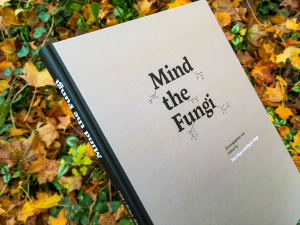
Mind the
Fungi
Hrs. v. Vera Meyer und Regine Rapp
Berlin 2020
Universitätsverlag der TU Berlin, deutsch und englisch
151 Seiten | 193 Farbabbildungen | 21 Schwarz-weiß Abbildungen |
28 x 21 cm | Buchgestaltung: Eva-Maria Bolz | Lektorat: Julia Kühn |
Druckerei: ProBusiness
Digitale Publikation | ISBN 978-3-7983-3169-3 | kostenfrei
http://www.artlaboratory-berlin.org/assets/pdf/Mind_the_Fungi.pdf
Hardcover | ISBN 978-3-7983-3168-6 | 24,90 EUR
https://verlag.tu-berlin.de/produkt/978-3-7983-3168-6/
Citizen-Science-Forschungsvorhaben, welches aus der Kooperation der Fachgebiete für Angewandte und Molekulare
Mikrobiologie und Bioverfahrenstechnik der TU Berlin sowie der Kunst- und Forschungsplattform Art Laboratory Berlin
entstand und Bürger_innen die Möglichkeit einer wissenschaftlichen Mitarbeit ermöglichte.
Die wissenschaftlichen und künstlerischen Wege im Mind-the-Fungi-Projekt, die wir gemeinsam mit der Öffentlichkeit
von 2018 bis 2020 gegangen sind, so auch die Art & Design Residencies, können jetzt mit diesem Buch in Texten und
Bildern nachverfolgt werden. Das Projekt hat einem breiten Publikum die Bedeutung der Pilzbiotechnologie für eine
nachhaltige Zukunft nähergebracht und an der TU Berlin ein Forschungsnetzwerk aufgebaut, in dem unter anderem mit
Citizen Scientists neuartige pilzbasierte Biomaterialien erforscht wurden.
Texte und Autor_innen:
Pilze als nachhaltige Biomaterialien | Bertram Schmidt, Bastian Schubert, Kustrim Cerimi, Carsten Pohl, Vera Meyer
Flechten als Reservoire für neue Naturprodukte | Zakieh Zakeri, Stefan Junne, Peter Neubauer
Kunst und Naturwissenschaft als Gemeinschaftsmyzelium | Regine Rapp, Christian de Lutz, Theresa Schubert,
Bertram Schmidt, Alessandro Volpato
Kunst- und Designresidenzen in den Laboren | Theresa Schubert, Fara Peluso
Wie Mind the Fungi ausstellen? Über das Co-Kuratieren von Pilzen und Menschen | Regine Rapp, Christian de Lutz
Transdisziplinär lehren und lernen | Kustrim Cerimi, Bastian Schubert, Birke Weber, Carsten Pohl,
Bertram Schmidt, Vera Meyer
Merging science and art through fungi (reprint) | Vera Meyer
On mycohuman performances: fungi in current artistic research (reprint) | Regine Rapp
Mit freundlicher Unterstützung der Technischen Universität Berlin durch das Programm „Citizen Science - Forschen mit der Gesellschaft“ und den Open-Access-Publikationsfonds.
Regine Rapp/
Christian de Lutz: "HYBRID ECOLOGIES. Artistic Research in 21 Century"
in:
Intersections Between Art and Science in the Anthropocene.
Quo Artis
https://quoartis.org/projects/intersections-between-art-and-science-in-the-anthropocene/
Publication date: 2021
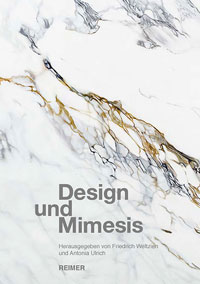
Regine Rapp:
Das Konzept Nonhuman Subjectivities. Aktuelle künstlerische
Praktiken im Posthumanismus, S. 67-85, in:
Design and Mimesis
Hrsg. v. Friedrich Weltzien and Antonia Ulrich
Reimer Verlag, Berlin 2019
http://www.reimer-mann-verlag.de/controller.php?cmd=detail&titelnummer=101610&verlag=4

Regine
Rapp/ Christian de Lutz: "Trans-, Post- and Beyond. Some Reflections
on machines and the Biological", S. 14-29,
in:
Half Life. Machines/ Organisms, Artistic Positions in the context of Climate
Change and Extinction.
Käthe Wenzel/Manfred Blohm (eds.)
Fabrico Verlag Hannover, 2018.
https://www.fabrico-verlag.de/bookshop/halflife/
Maschinen-Organismen, organische Maschinen: Die Auflösung der Grenzen zwischen Körpern und Mechanik ist auf dem Weg zur Normalität: fühlende Prothesen, Neuroimplantate, Neuroenhancement – Posthumanismus. Das Artensterben soll durch synthetische und mechanische Organismen ausgeglichen werden. Wie werden diese Entwicklungen künstlerisch weiter gedacht? Welche Drohungen und Versprechungen zeichnen sich ab? 41 künstlerische Positionen aus 15 Ländern liefern kritische bis visionäre Vorlagen zu den Gebieten: Sozio-emotionale Service-Maschinen: Stellvertreter und soziale Krücken; Ersatz: Maschinen-Umgebungen und künstliche Organismen; Utopie: Prothesen, Utopische Instrumente und Ersatzkörper; Verbindung: Vermittlungsmaschinen und Kommunikation zwischen den Spezies; Autonome und obsolete Maschinen: vergangene Maschinenkulturen.
Mit
Agnes Meyer-Brandis, Alex May, Alexander Schellbach, Andras Böröcz, Anna Dumitriu, Christa Sommerer, Claudia Schmitz, Courtney Johnson, Emma Critchley, Giuliana Cunéaz, Guy Ben-Ary, Hannes Waldschütz, Ionat Zurr, Jeongmoon Choi, Ji Hyun Park, Jinyoung Lee, John Roach, Käthe Wenzel, Kerstin Ergenzinger, Laurent Mignonneau, Lisa Glauer, Lorenzo Oggiano, Lukas Truniger, Malte Bartsch, Marie-Eve Levasseur, Michael Schulze, Nicola L. Hein, Oron Catts, Pey-Ying Lin, PSJM, Robbin A. Silverberg, Robertina Šebjanic, Saša Spacal, Špela Petric, Susanna Hertrich, Susanna Schoenberg, Suzanne Anker, Tobias Grewenig, VALIE EXPORT, Verena Friedrich, Via Lewandowsky, 431art
...und einführenden Texten von KätheWenzel/ Manfred Blohm, Regine Rapp/ Christian De Lutz, Lisa Glauer/ Helge Oder.

Interdisziplinäre
Konferenz
Nonhuman Agents in Art, Culture and Theory
24. -26. November
2017
Als
theoretische Ergänzung zu unserer laufenden Reihe Nonhuman Agents
(Juni - Dezember 2017) vereinte Art Laboratory Berlin - gemeinsam mit
unseren Partnern, dem Institut für Kunst und Medien, Universität
Potsdam - internationale Künstler, Wissenschaftler aus Natur- und
Geisteswissenschaften verschiedener Disziplinen, um künstlerische,
philosophische, ethische und naturwissenschaftliche Ansätze über
nichtmenschliche Akteure zu diskutieren. Bisherige Positionen aus unserer
Reihe Nonhuman Subjectivities (2016-17) wurden miteinbezogen.
http://artlaboratory-berlin.org/html/de-event-40.htm
Auf unserer
Konferenz-Website sind sämtliche Videoaufnahmen von allen KonferenzsprecherInnen!
Sie haben/ Ihr habt unbegrenzten Zugang zu jedem einzelnen Konferenzbeitrag
(Videoaufnahme & Abstract)!
Art Laboratory Berlin bietet diesen Service ohne Gebühr an.
Wir freuen uns über jede Form der Spende
(unsere Spendenquittungen sind von der Steuer absetzbar).
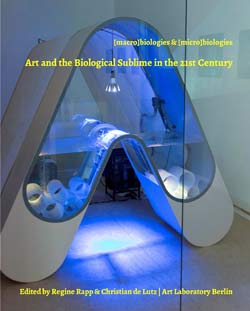
[macro]biologies
& [micro]biologies.
Art and the Biological Sublime in the 21st Century.
Hrsg. v.Regine Rapp & Christian de Lutz, Berlin 2015
98 Seiten
96 Farbfotografien
20 x 25 cm (geschlossen)
Konzept: Regine Rapp & Christian de Lutz
Layout: Eva Jera Hanžek
Sprache: englisch
Gedruckt bei Blurb
Softcover: 39 EUR
Leinencover mit Schutzumschlag: 48,90 EUR
Bedrucktes Harcover: 49,90 EUR
eBook: 7,99 EUR
PDF: 4,99 EUR
Dieses Buch
ist eine nachhaltige Ergänzung zur Serie [macro]biologies &
[micro]biologies, die bei Art Laboratory Berlin zwischen 2013 und
2015 stattgefunden hat. Das gesamte Programm bestand aus vier Gruppenausstellungen,
mehreren Seminaren und Gesprächen über zeitgenössische
Kunst und die Lebenswissenschaften. Die vier Ausstellungen - the biosphere,
organisms, the bacterial sublime und proteo - zeigten herausragende internationale
Künstlerinnen und Künstler, die an der Schnittstelle von Kunst
und verschiedenen Feldern der Biologie arbeiten. Neben der vertieften
theoretischen Reflexion über die ausgestellten Künstlerinnen
und Künstler präsentiert die vorliegende Publikation auch Künstlertexte
und dokumentiert eine Reihe hervorragender Veranstaltungen der Serie -
Workshops und Seminare mit den Künstlerinnen und Künstlern,
Biologinnen und Biologen, Wissenschaftlerinnen und Wissenschaftlern zu
Themen der synthetischen Biologie, des spekulativen Designs, zu DYI-Bio
Praktiken und zum Phänomen citizen science.
Weitere Informationen über
die [macro]biologies & [micro]biologies Serie
AutorInnen
& Beiträge
Regine
Rapp & Christian de Lutz: Art and the Biological
Sublime in the 21st Century, S. 8-52
Katya Gardea Browne: Rhythms of a Living World, S. 61
Richard Pell: The Center for PostNatural History, S. 62
Mathias Kessler: Nature and Us - Between Boundless Desires and
Limited Compassion, S. 64
Alexandra Regan Toland: Mapping the Urban Grind Mill, S. 66
Suzanne Anker: Petri's Panoply, S. 69
Maja Smrekar: BioBASE - The Eco Utopian Agent, S. 71
Brandon Ballengée: The Cry of Silent Forms, S. 72
Anna Dumitriu: The Bacterial Sublime, S. 75
Joanna Hoffmann: πρωτεο
/ proteo, S. 76
Pinar Yoldas: Reflecting my Artistic Practice and Collaborating
with Art Laboratory Berlin, S. 79-80
Denisa Kera: Biostrike as Soil Art: Biotech Guerrillas in the Post-Antibiotic
Age, S. 83-88
Desiree Förster: Under the Surface, under the Skin. The Use
of Synthetic Biology within the Artistic Practice of C-LAB, S. 93
Die
Publikation ist erhältlich bei blurb.com, blurb.de und blurb.co.uk.
Hier
bestellen (DE)
Hier
bestellen (US)

Anna
Dumitriu. The bacterial sublime.
Hrsg.
v. Regine Rapp & Christian de Lutz, Berlin 2014
34 Seiten
15 Farbfotografien
20 x 25 cm (geschlossen)
Gedruckt bei Blurb
Softcover: 26.54 EUR
Leinencover mit Schutzumschlag: 34.91EUR
Bedrucktes Harcover: 35.84EUR
eBook: 10.99 EUR
PDF: 7.57 EUR
Der Katalog präsentiert die Ausstellung [micro]biologies I: the bacterial sublime mit Arbeiten von Anna Dumitriu, die bei Art Laboratory Berlin im Herbst 2014 stattgefunden hat. Die Retrospektive wurde von Regine Rapp & Christian de Lutz kuratiert und stellt einen Teil der größeren Ausstellungsserie [macro]biologies & [micro]biologies dar. In der Publikation ist auch der Essay The bacterial sublime. Reflectinos on the art of Anna Dumitriu, a unique 'infective agent' in the culture of scientific investigationvon Regine Rapp & Christian de Lutz erschienen. Weitere Informationen zur Austellung
Die Publikation
ist erhältlich bei blurb.com, blurb.de und blurb.co.uk.
Hier
bestellen (DE)
Hier
bestellen (UK)
Online Publikation

Wir freuen uns sehr, mit Ihnen/ Euch unsere Online-Publikation der zweitägigen
internationalen, interdisziplinären Konferenz zu teilen, die bei
Art Laboratory Berlin im Sommer 2013 stattgefunden hat:
Synaesthesia.
Discussing a Phenomenon in the Arts, Humanities and (Neuro-)Science
http://www.artlaboratory-berlin.org/html/de-event-17.htm
Auf unserer Konferenz-Website sind sämtliche Videoaufnahmen von
allen KonferenzsprecherInnen!
Sie haben/ Ihr habt unbegrenzten Zugang zu jedem einzelnen Konferenzbeitrag
(Videoaufnahme & Abstract)!
Art Laboratory Berlin bietet diesen Service ohne Gebühr an.
Wir freuen uns über jede Form der Spende
(unsere Spendenquittungen sind von der Steuer absetzbar).
Christian
de Lutz: "Is the Desert Still the Desert in a Digital World?"
S. 85-6 in
Warnayaka Art Centre: Life in the Digital Desert
Gretta Louw, Barbara Glowczewski , Jennifer Biddle (eds.)
IDAIA 2013
http://www.idaia.com.au/en/book-warnayaka-art-centre-life-in-the-digital-desert/
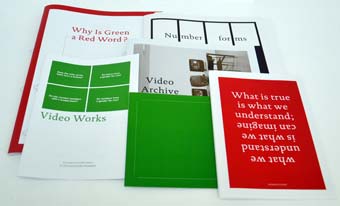
Ditte
Lyngkær Pedersen:
Why is Green a Red Word?
Hrsg. v. Art Laboratory Berlin, Berlin 2013
Limitierte Auflage, signiert von der Künstlerin
Auflage:
250 Exemplare
Die graphemisch und räumlich synästhetisch begabte Künstlerin
Ditte Lyngkær Pedersen hat seit 2003 ein umfangreiches Videoarchiv
mit Interviews zur multisensorischen Wahrnehmung von Synästhetikern
angelegt, die die Erfahrungen Einzelner dokumentieren und zugleich die
unüberbrückbare Kluft zwischen dem individuellen Themengebiet
und dem Publikum deutlich machen.
Ihr Projekt Why Is Green a Red Word? präsentiert Interviews mit Synästhetikern und Wissenschaftlern, des weiteren werden konzeptuelle Videoarbeiten wie What the Hell does Purgatory Look Like? gezeigt. Eine Serie von Zeichnungen visualisiert die räumliche Vorstellung von Zahlen unterschiedlicher Synästhetiker. Zur Ausstellungseröffnung erscheint das Künstlerbuch Why Is Green a Red Word? von Ditte Lyngkær Pedersen
Graphik-Design von Kenan Darwich
http://www.artlaboratory-berlin.org/html/de-ausstellung-archiv.htm
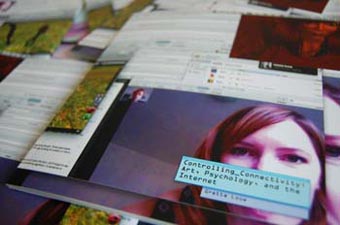
Art, Psychology and the Internet.
Berlin 2012
59 pages, color photographs
21 x 21 cm (closed), 21 x 42 cm (open)
Softcover, 4-color images
Collectors Edition, signed by the artist
Edition: 100
Christian de Lutz: "Too Artful to be a Virtual Soul": Performance, Psychology and Social Media, p. 27-31
Regine Rapp: "It Feels Like They're Talking Inside My Own Head": Formats and Image Strategies in Gretta Louw's Controlling_Connectivity, p. 36-38
Emmy Doyle: Psychometric Testing Pre- and Post-Performance, p. 46-47
DeeAnna Merz Nagel: Internet Addiction. Really?, p. 48-49
Leon Tan: Reconfiguring Co-Presence: An Ontology of Networked Social Relations, p. 51-53
In her project Controlling_Connectivity Louw explores to what extent an
extreme use of the Internet and our belief in the online connectivity
can have psychological consequences. Her inquiry questions self-censorship
and socially acceptable forms of behaviour in the face of the constant
pressure put in place by society's inexorable increasing need for connectivity.
For 10 days in November 2011 the artist was available 24 hr/day for discussions, emails, comments, or interviews - of both private and professional nature - for any Internet user wishing to take part in the project. All necessary supplies were stored within the gallery and the windows were blacked out to en-sure that the environment was not normalized by natural light or the social rhythms outside, but de-fined purely by the internet connection to external participants. A number of planned online events (the artist's 30th birthday; live talks and performances with partners in New York, Japan, Denmark and Berlin; interviews with press, etc.) were scheduled at intervals throughout the performance.
More information:
http://artlaboratory-berlin.org/html/de-ausstellung-24.htm
http://controllingconnectivity.tumblr.com/
http://grettalouw.com/conconn%20artist%20book.pdf
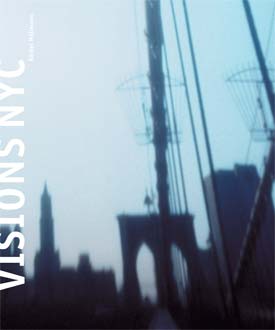
Portraits and Interviews from New York.
Berlin 2011
272 pages, 136 camera obscura photographs
Interviews (each 4-15 min.), on 4 CDs
Essay by Regine Rapp: The Inner Eye and Extended Time. Reflecting upon Bärbel Möllman's Project VISIONS NYC. (German and English)
25 x 30 cm
(closed), 50 x 30 cm (open)
Hardcover, 4-color images
Collectors Edition, signed by the artist
Edition: 25
In the project VISIONS NYC the Berlin-based artist and photographer Bärbel Möllmann has gathered a series of amazing camera obscura photographs and interviews with New Yorkers from July and August 2001, recording their individual plans, goals and dreams, and from Summer 2002 recording their reac-tions to the events of the previous year.
In the photo book the portraits from New York are collected in a volume as large format color photo-graphs. Sometimes the wide-format images extend over double pages. The photo book is able, as a special bibliophile medium, to give space to individual life concepts. The pages constitute a central moment in the reception process, sequentiality and seriality by the ordering of book pages, to meet the heart of urban agglomeration and diversity of urban life. Not least through its archival nature the artist's book provides an ideal format for this unusual and material rich project.
More information
about the project and the exhibition
http://artlaboratory-berlin.org/html/de-ausstellung-23.htm

SOL
LEWITT. Artist's Books.
Ed. By Maffei, Giorgio/ de Donno, Emanuele.
Mantua: Corraini Edizioni 2010
ISBN 978-88-903459-2-0
The exhibition SOL LEWITT. Artist's Books opening at Art Laboratory Berlin on 21 January presents the complete oeuvre of 75 artists' books produced by the American conceptual artist Sol LeWitt, dating from 1967 to 2002. This exhibition pays tribute to the unique bibliophile production of the artist, who died in 2007.
The American
artist Sol LeWitt (1928 - 2007) was an influential figure in minimalism
and is considered one of the most important representatives as well as
co-founder of American conceptual art. The term "conceptual art"
goes directly back to LeWitt: "If the artist carries through his
idea and makes it into visible form, then all the steps in the process
are of importance. The idea itself, even if not made vis-ual, is as much
a work of art as any finished product. All intervening steps - scribbles,
sketches, draw-ings, failed works, models, studies, thoughts, conversations
- are of interest. Those that show the thought process of the artist are
sometimes more interesting than the final product."
(Paragraphs, Artforum, June 1967)
More information
about the exhibition:
http://artlaboratory-berlin.org/html/de-ausstellung-21.htm
More information
about the Sol LeWitt_Symposium:
http://artlaboratory-berlin.org/html/de-event-10.htm
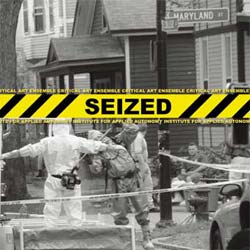
Berlin 2009
44 p., color,
text in English and German
ISBN: 978-3-9813234-0-5
The exhibition SEIZED deals with the FBI raid on the home of CAE member and art professor Steve Kurtz in Spring 2004 and the four year law case that followed. In May 2004 Steve's wife Hope died en-tirely unexpectedly because of an undiagnosed heart defect. Emergency responders from the Fire De-partment who answered Kurtz's call saw a chemistry laboratory, which was part of preparations for an upcoming show, in the couple's house. The Fire Department found this suspicious and informed the FBI. During the three-day-raid the authorities not only confiscated Kurtz's computers, archives, art-works and a set of books he was using for research on his upcoming book project, but also his wife's corpse. Steve himself was interrogated for 22 hours with the aim of charging him with "bioterrorism" and even murder. Later the charges were changed to to "wire and mail fraud", which finally, in 2008, was dropped due to all evidence of a crime being "insufficient on its face."
In their installation Body of Evidence the artists turn the perpetrator-victim-relationship upside-down. As the FBI had stolen their artistic material, they, in return, confiscated the debris left behind on Steve Kurtz's lawn by the FBI agents - pizza boxes, Gatorade bottles, hazmat suits and biological sample bags, as well as written notes and a single cigar butt. The exhibition's curators Regine Rapp and Chris-tian de Lutz write about this in the exhibition catalogue:"The display of the notes and papers which the federal agents wrote during their raid resembles a strategy of counter-appropriation in which CAE and IAA convert those objects left behind as "evidence" for their own investigation. All in all, this turns the 'case' inside out and subverts the power structure. The items confiscated are exchanged for items left behind, which in turn form the basis for the exhibition. In a strange act of reciprocity, the artists are able to invert the whole investigator/perpetrator system. The blank space created by the seizure of CAE's artworks is filled by the debris of the state; and with this the absence of the seized objects is made more tangible."
More information:
http://artlaboratory-berlin.org/html/de-ausstellung-15.htm
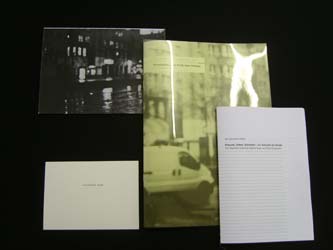
Prinzenallee
- Ein Stück ohne Dialoge.
Ed. by Birgit Szepanski and Regine Rapp for Art Laboratory Berlin. Berlin
2009.
Artist Book,
36 pages
Texts
in German language
ISBN 978-3-9813234-1-2
As part of the exhibition series "Art and Text" Birgit Szepanski will present a site specific work for Art Laboratory Berlin. Prinzenallee. A Play without Dialog is an installation encompassing both exhibition rooms, and relating to the street outside the art space in Berlin-Wedding. Film, photography and text envisage traces of this street. In an explicitly minimalist manner the street unfolds into the exhibition space. In her texts Birgit Szepanski consciously lets different literary genres intermingle: Description and narration, transcripts and monologues transform the play into an urban labyrinth, where fiction and reality seem to oscillate. The exhibition space becomes a crime site and the visitor a voyeur, who enters intimate urban zones through image, sound and text.
"The
graphic and spatial transformation of the urban theme in the exhibition
space resembles Gaston Bachelard's description of Topo-analysis as the
"study of the locality in our inner life". This publication
shows excerpts of artistic work - photography as well as five fictive
texts - that formed the exhibition, and mirrors in their formal composition
of Birgit Szepanski's special aesthetic of text and image instal-lations.
The chosen bibliophile medium accommodates the artists formal language
especially well."
(Regine Rapp, from the essay "Vom Oszillieren urbaner Zeichen"
("On the oscillation of urban signs") of the publication)
More information
about the project:
http://artlaboratory-berlin.org/html/de-ausstellung-6.htm
| Art Laboratory Berlin dankt der Unterstützung von: | |||